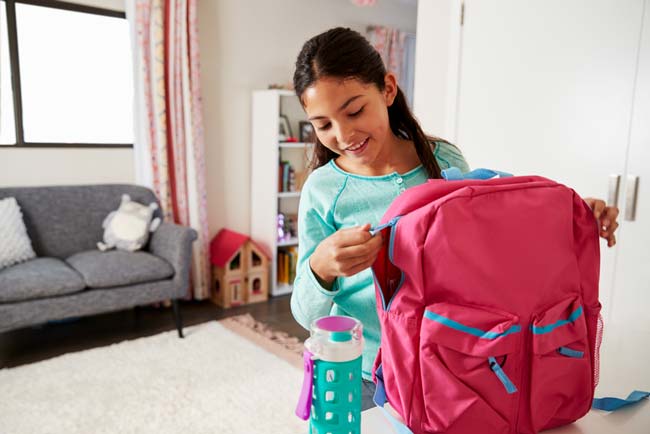The backpack. It’s one of those items that’s on every kid’s back-to-school list — and choosing the right one is very important.
We know it’s important for kids to choose a backpack that’s easy on the eyes and maybe includes hit characters from the latest TV show or movie.
But it’s also important to choose the right backpack in another sense.
Have you ever picked up your child’s backpack after school and wondered why it felt like there was a brick inside? These days, those bags are often weighted down by tons of books, binders and even electronic devices.
And all that weight can be dangerous. Research studies have shown that backpacks loaded down with books and other items can cause harmful effects on the spine of growing kids.
How can you help your kids sidestep that danger? Let’s take a look at a few key steps.
Choose an appropriate backpack
OK, so you’re probably wondering, “What makes a backpack appropriate?”
Well, when you’re looking at a backpack, you want to look for two key attributes: wide, padded shoulder straps and a padded back. A backpack with two straps is important for evenly distributing weight across the body.
There are also other characteristics to look for in a backpack:
- Lightweight material that doesn’t add a lot of weight to the backpack
- A waist belt, which helps distribute weight
- Multiple compartments inside to help further distribute weight
Use the backpack appropriately
While we’re focusing on choosing the right backpack during this back-to-school season, how the backpack is used is just as important.
The first and most important tip: Backpacks should not be overloaded.
The American Academy of Pediatrics recommends that backpacks hold no more than 10 to 20 percent of your child’s body weight. That includes both the backpack itself and its contents.
So, if your child weights 75 pounds, his or her backpack should weigh no more than 7.5 pounds to 15 pounds at most.
Inside the backpack, items should be distributed into all the compartments to evenly carry the weight. Heavier items should be closest to the center of the back.
Let’s also return to the importance of the two straps. You found a backpack with two padded shoulder straps. Now your little one needs to actually use both straps.
It can be easy to simply sling the bag across one shoulder or the other, but that unevenly distributes the weight and can lead to discomfort or even injury.
You’ll also want to adjust the backpack straps so that the bottom of the bag rests at your child’s waist.
How to lessen backpack weight
So how can you make sure your child isn’t carrying too much? There are a few strategies you can have your child follow.
- Encourage your child to use his or her locker or desk rather than carrying everything home at night or around the school during the day.
- Require that certain items that aren’t needed at school, like electronic devices and video games, be left at home. These items can add unnecessary weight.
- Look at obtaining duplicates of certain school-related items so that one set can stay at school and the other at home — meaning they wouldn’t need to be carried to and from school.
- Let your child know to only bring homes the specific books and other items needed to complete that night’s assignments. No sense in lugging around things that aren’t needed.
You can also help limit the risk of strain on your child’s back and shoulders by teaching him or her to lift the bag properly. When the backpack is fully loaded, it should be lifted like any other heavy weight — by bending at the knees and grabbing it with both hands.
One item you can go ahead and mark off your back-to-school list? Your child’s annual checkup. Schedule it today if you haven’t already!







